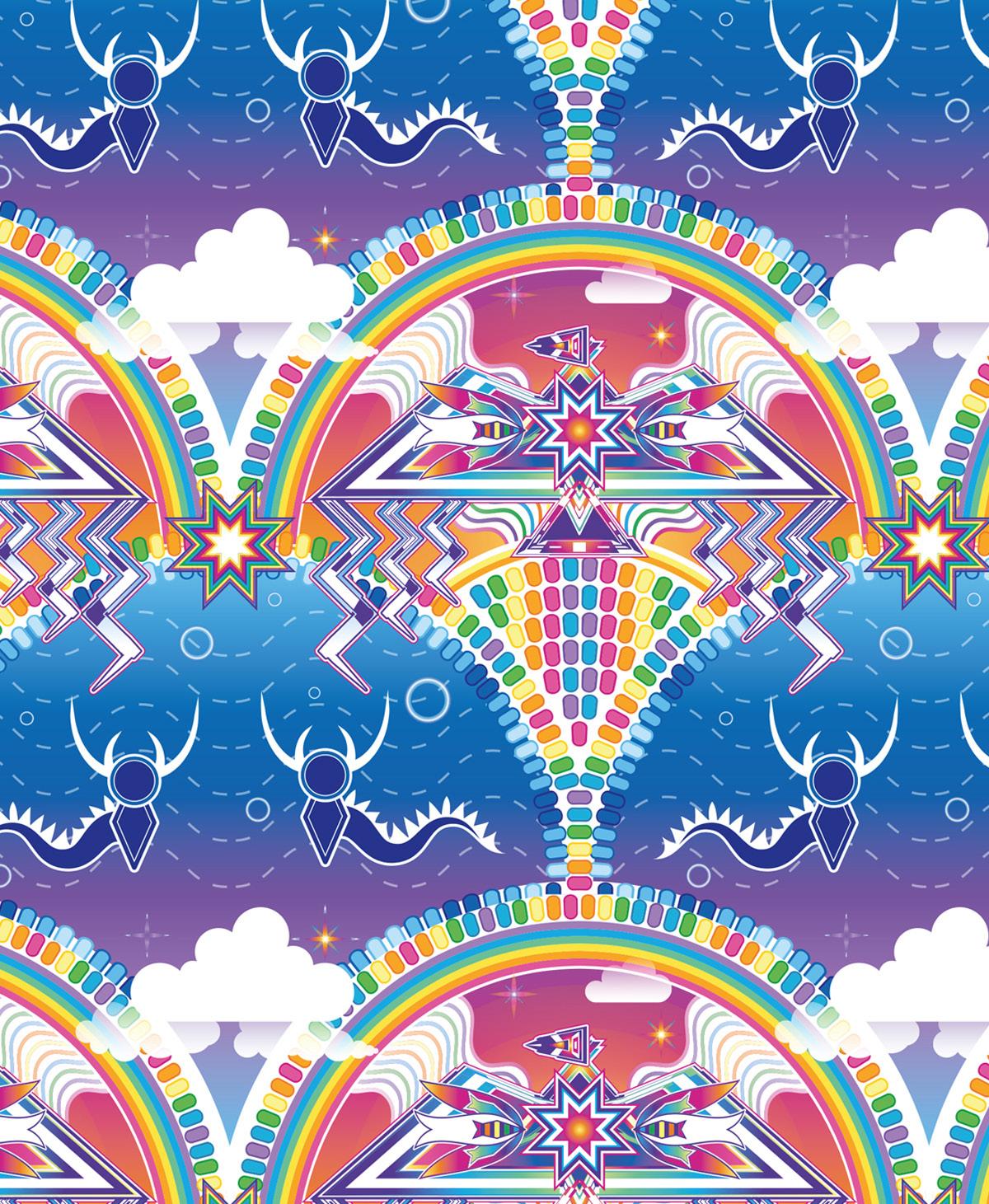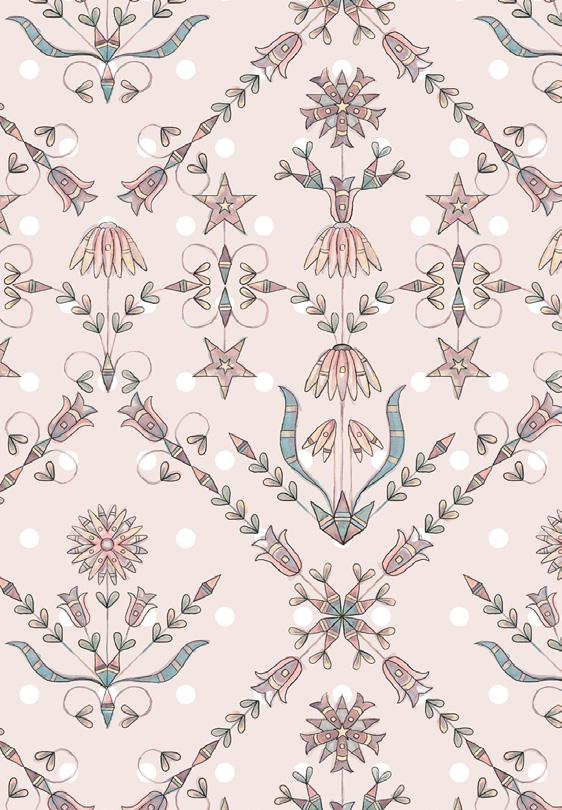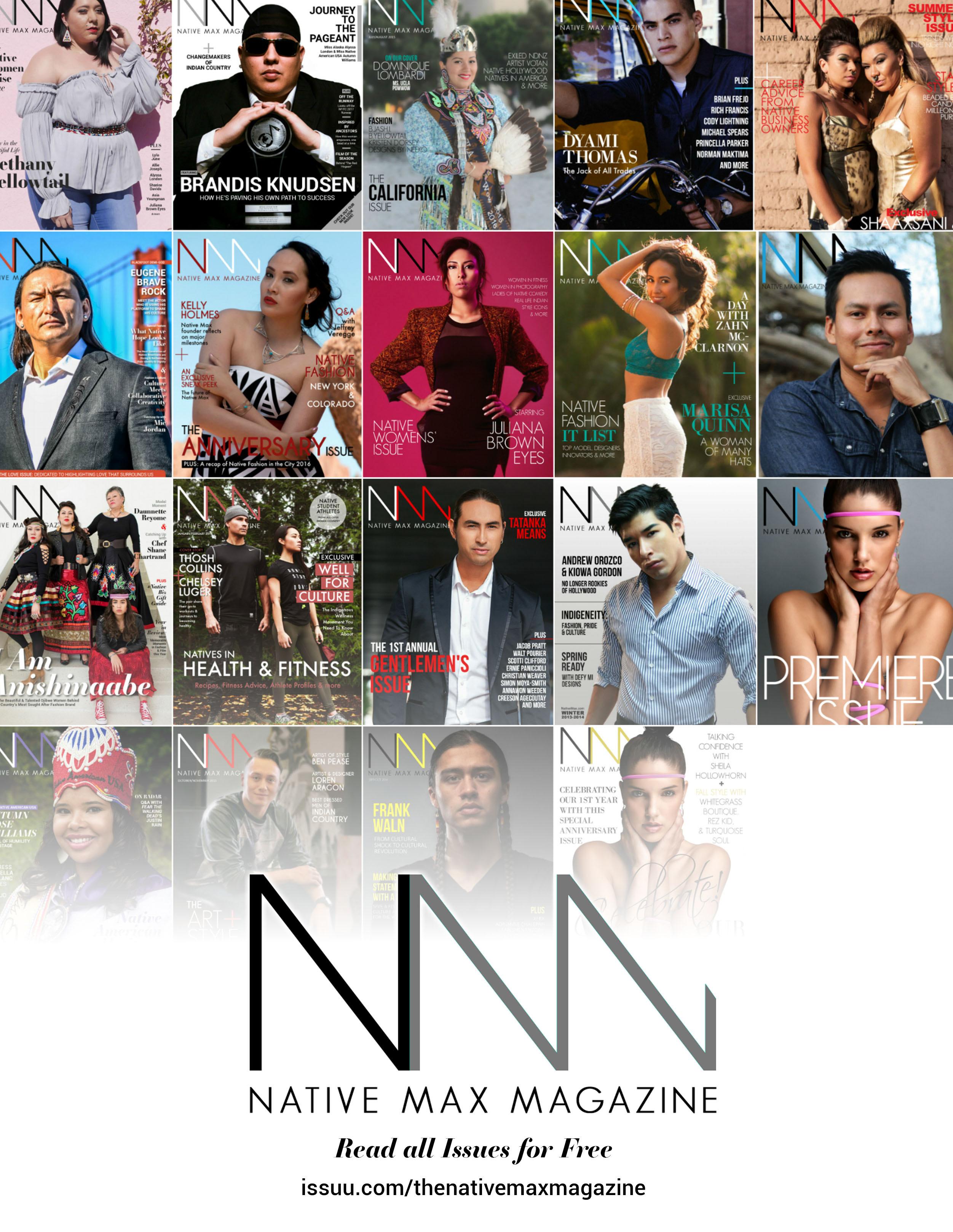
7 minute read
THE FUSION OF ART & FASHION: MARLENA MYLES
Left: One of Myles’ fabric prints for sale, pattern 1 from series Dakota Deco
Marlena Myles
Advertisement

Plenty of artists have made moves into the fashion world, and vice versa. We spoke with digital artist and illustrator (turned fabric designer) Marlena Myles about her experience of fusing digital art with style and the inspiration behind some of her iconic fashion patterns.
Like other millennials, Marlena Myles (Dakota, Mohegan, Muscogee Creek) developed her knack for digital arts on a computer with dial-up internet. "I got into making my own websites, drawing comics, and creating graphics of my favorite musicians," she says. "So, my passion for computer-generated art started at an early age." Myles, originally from the Spirit Lake Dakota Tribe in North Dakota, is also self-taught since she grew up alongside the growth and progress of technology and the net. "The programs and software have gotten a lot better since then, and there are so many fun ways to explore your imagination with technology these days." Myles grew up in Minneapolis, Minnesota, and Rapid City, South Dakota; all on the traditional homelands of the Oceti Sakowin (Dakota, Lakota, and Nakota tribes). Myles' accomplishments are impressive: she's created works for children's books, coloring books, animations and has fine art in galleries such as the Minneapolis Institute of Art, Red Cloud Heritage Center, the Minnesota Museum of American Art, the South Dakota Art Museum, and the Museum of Nebraska Art, to name a few. She creates her digital art using
Adobe Illustrator, a highly intricate and advanced vector graphics editor, and design software program. "Each piece consists of hundreds of layers, gradients, and shapes placed upon each other," Myles explains. Though she uses modern-day technology to design her graphics, Myles indeed incorporates elements of traditional Native art. "When people think of Native American art, they may recall the abstract geometric styles that were historically used by women, or the figurative war scenes created by men, but my art combines both in a fresh way to revamp what people might think of Native art." Myles is a self-taught digital artist working with various mediums–digital art, animation, and illustration. One of her main motivations for creating art is to pass on knowledge to the next generations using the modernity that surrounds Native people to show the world that our cultures are still very much relevant; that they are a source of power. This is what pushes Myles to continue integrating the stories of her people through graphic art. "The common misconception with Native art is that it's traditional, stuck in the past," she says. "But the truth is that Native people have always been innovative. So to use Illustrator is just a continuation of what my ancestors already did." As a youth, Myles was always interested in learning her Dakota culture, but there was a lack of materials and resources. "There weren't a lot of materials out there for me to learn from as a kid that taught plant knowledge, star knowledge, about our traditional spirituality." As an adult, she found inner-strength from studying more about her culture, which is why she wants to make sure the next generations can have that opportunity as well. "I think almost all Native people find value and meaning in passing down knowledge to the future generations using whatever gifts they have to do so." This motivated Myles to apply her artistic talents to educational opportunities: she has illustrated books, murals, and coloring books along with other pieces that teach the Dakota language and the history of their lands. She's even animated music videos. "My plans for next year include branching out into augmented reality and possibly video games to showcase our culture in new ways." Myles has recently taken on fashion with her online fabric store, where customers can have her designs printed and used in their creations. Some of her Dakota fashion patterns are a fusion between her Native culture and various memorable art and fashion design movements such as art deco and '60s mod. Myles also sells merchandise such as shirts, backpacks, leggings, and masks featuring her graphic art. We sat down with Myles to talk about her experience of using fashion to express herself, how she fuses digital art with style, and the inspiration behind some of her iconic fashion patterns.
As an award-winning, multi-talented Native American artist, what perspective do you bring to your art?
I think one of the common misperceptions of Native art is that it's stuck in the past, that being "traditional" means doing things in a certain fashion. The truth is, Native people, have always been innovative, so using the technology I'm using to share our cultural wealth is just a continuation of what our ancestors have been doing since time immemorial. I'm a fan of different cultures worldwide, so I like to adapt to the Dakota style of art into different styles. I think if people look at my art, they might see Native art done in a way they've never seen before but still tell it's closely tied to our fundamental values.
Besides using modern mediums such as digital art, you're also a fabric and fashion designer. How did you also become a fabric and fashion designer?
Fashion has always been a great way to express myself; when I first started my professional art career, I was shy at talking to people at art exhibitions. However, the cool outfits I would put together just for the event would always be a great ice breaker, so fashion helped me become confident. If you look at our ancestors' old photos, you can see their confidence through the way they present themselves with their beautiful fashions. Understanding that power and strength that comes from how one is dressed, I wanted to create fabrics for other designers to use in their designs because I think there's a pretty limited selection of fabrics made by Natives for Natives. I have an online fabric store where people can have my designs printed and used in their creations. A few designers have even produced entire lines for fashion shows using them, so it's great seeing folks being inspired by my fabrics. I try to do innovative things with the designs to test both myself as a designer and open people's minds to what Native fashions can be.
How do you convey the rich culture and history of the Native person/people to the viewer through fashion?
I like to include Dakota's ancient stories as well as Dakota plant knowledge in my works. I researched the medicines our ancestors would use in their quill
A few of Myles’ fabric prints. Top: Thunderbird VS Underwater Serpent. Right: Watercolor Dakota Floral. Shop for Myles’ fabrics on her website WWW.MARLENAMYL.ES.


work and beadwork, some were created to protect the wearer of the designs, so I wanted to keep that tradition going with my fabrics. Even though they have different international art movements as the basis for the patterns (such as Art Deco, Art Nouveau, '60s Mod, etc.), the art is always uniquely Dakota in the end. One of the fabric designs includes the ancient story of the Thunder being and Underwater Serpent that can be seen on petroglyphs dating back over 10,000 years old; I thought it would be fun to create a pattern that drew on those ancient stories and mix it with the colorful style of Lisa Frank that I loved as a kid. I imagine there are little ones out there who would also love the colors and feel proud that our ancient stories are still fashionable.
How does it make you feel when you see other Indigenous designers creating designs with your fabric?
I feel motivated to keep creating new designs. Many of the designs I've seen were done in ways I hadn't even imagined the designs would be used. I end up growing as an artist myself looking at their creations: their works influence what I should create next in order, so it's a fun feedback loop!
How have you been dealing with and working during the COVID-19 pandemic?
I've been pretty keen on practicing socially distancing, so it's mostly me staying home and working on projects or taking walks to nearby parks. The fabric shop I use to print my designs had to limit their workers for obvious safety measures, so there was a huge delay in getting fabrics printed, so I decided to wait until recently to add new designs to my shop after making adjustments to protect their workers. Besides creating fabrics, I've been working on creating illustrations for magazines, newspapers (such as the Washington Post), my upcoming coloring book, animations, and working on window vinyl murals for the City of Minneapolis.











